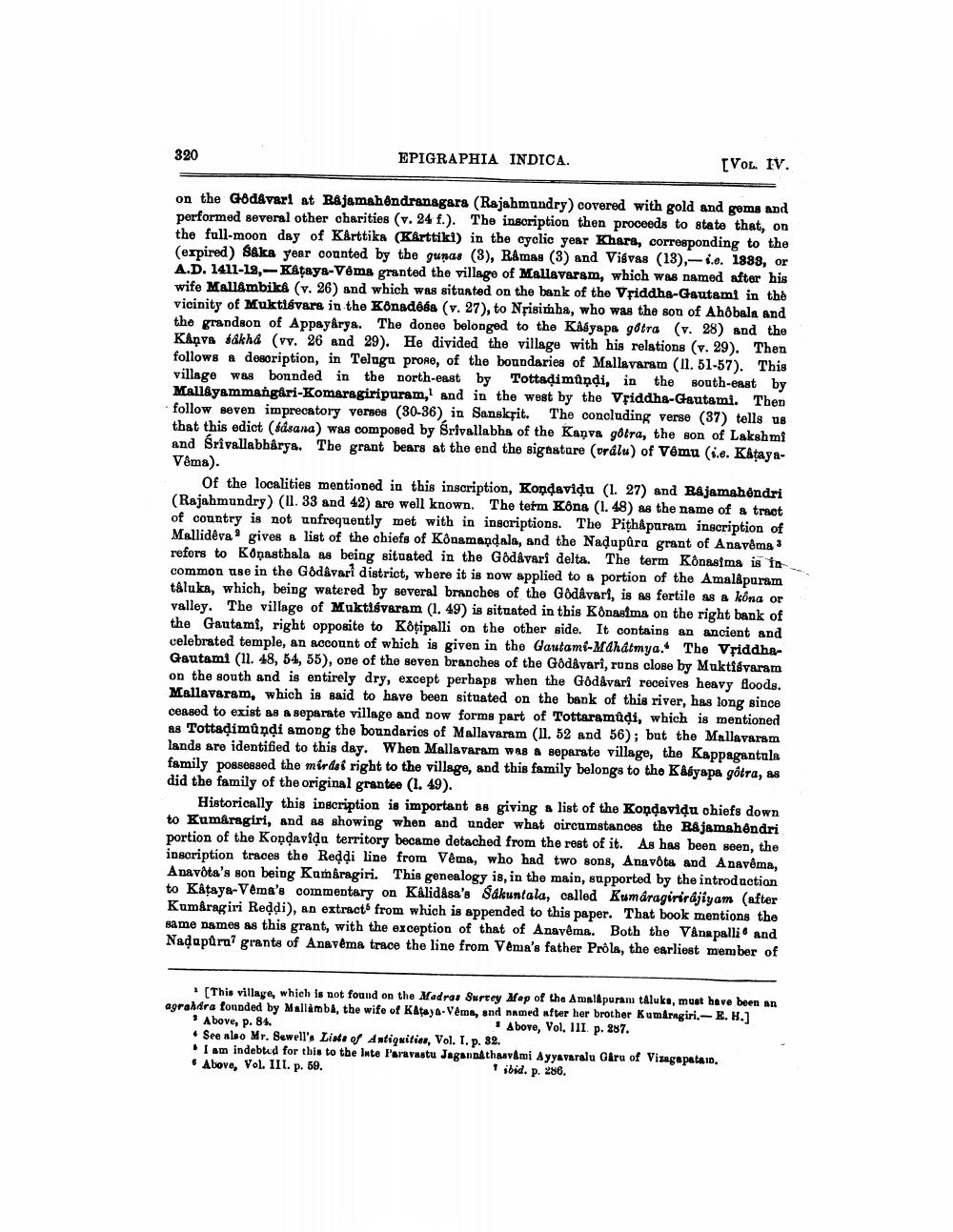________________
320
EPIGRAPHIA INDICA.
[VOL. IV.
on the Godåvari at Rajamahendranagara (Rajahmundry) covered with gold and gems and performed several other charities (v. 24 f.). The inscription then proceeds to state that, on the full-moon day of Karttika (Karttiki) in the cyclic year Khara, corresponding to the (expired) Saks year counted by the gunas (3), Råmas (3) and Visvas (13), s.e. 1888, or A.D. 1411-12,- Kåtaya-Vêma granted the village of Mallavaram, which was named after his wife Mallámbika (v. 26) and which was situated on the bank of the Vriddha-Gautami in the vicinity of Muktiśvara in the Könadesa (v. 27), to Nộisinha, who was the son of Ahobala and the grandson of Appsy&rya. The doneo belonged to the Kabyapa götra (v. 28) and the Kanva sakha (vv. 26 and 29). He divided the village with his relations (v. 29). Then follows a description, in Telugu prone, of the boundaries of Mallavaram (11. 51-57). This village was bonnded in the north-east by Tottaờimûndi, in the south-east by MallAyammangári-Komaragiripuram, and in the west by the Vriddha-Gautami. Then follow seven imprecatory verses (30-36) in Sanskrit. The concluding verse (37) tells us that this edict (sâsana) was composed by Srivallabhs of the Kaņva gôtra, the son of Lakshmi and Srivallabharya. The grant bears at the end the signature (urdlu) of Vému (i.e. KatayaVêma).
Of the localities mentioned in this inscription, Kondavidu (1. 27) and Rajamahendri (Rajahmundry) (11. 33 and 42) are well known. The term Kona (1. 48) as the name of a tract of country is not unfrequently met with in inscriptions. The Pithapuram inscription of Mallidêvas gives & list of the chiefs of Konamandala, and the Nadupûra grant of Anavêma 3 refors to Konasthala as being situated in the Godavari delta. The term Kônasima is in common use in the Godavari district, where it is now applied to a portion of the Amalapuram tâluka, which, being watered by several branches of the Godavari, is as fertile as a kóna or valley. The village of Muktiśvaram (1. 49) is situated in this Konasima on the right bank of the Gautami, right opposite to Kotipalli on the other side. It contains an ancient and celebrated temple, an account of which is given in the Gautami-Mahatmya. The VriddhaGautami (11. 48, 54, 55), one of the seven branches of the Godavari, runs close by Mukti varam on the south and is entirely dry, except perhaps when the Godavari receives heavy foods. Mallavaram, which is said to have been situated on the bank of this river, has long since ceased to exist as a separate village and now forms part of Tottaramuļi, which is mentioned as Tottadimûndi among the boundaries of Mallavaram (11. 52 and 56); but the Mallavaram lands are identified to this day. When Mallavaram was a separate village, the Kappagantala family possessed the mirds right to the village, and this family belongs to the Kåbyapa gôtra, as did the family of the original grantee (1. 49).
Historically this inscription is important as giving a list of the Kondavidu chiefs down to Kumaragiri, and as showing when and under what circumstances the R&jamahendri portion of the Kondavidu territory became detached from the rest of it. As has been seen, the inscription traces the Reddi line from Véma, who had two sons, Anavota and Anavêma, Anavõta's son being Kamaragiri. This genealogy is, in the main, supported by the introduction to Kåtaya-Vema's commentary on Kalidasa's Sakuntala, called Kumaragirirajiyam (after Kumâragiri Reddi), an extracts from which is appended to this paper. That book mentions the same names as this grant, with the exception of that of Anavêma. Both the Vånapalli and Nadapura? grants of Anavema trace the line from Vema's father Prôla, the earliest member of
* (This village, which is not found on the Madras Surrey Map of the Amal&puram taluka, must have been an agrahara founded by Mallámba, the wife of Kataya-Vême, and named after her brother Kumaragiri.-E. H.] Above, p. 84.
Above, Vol. 111. p. 287. • See also Mr. Sewell's List of Antiquities, Vol. I. p. 82.
I am indebted for this to the Inte Paravastu Jagannathasv&mi Ayyavaralu Garu of Vizagapatain, & Above, Vol. III. p. 59.
ibid. p. 286.




